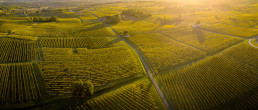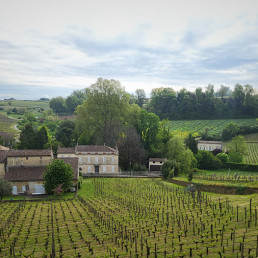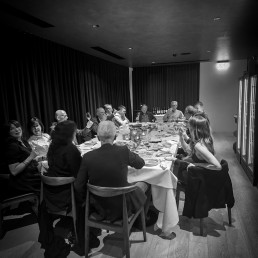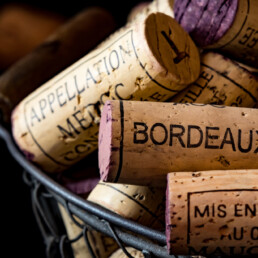“We have produced wines that are classic, with fruit to the fore”
Nicolas Labenne, Château Lynch-Bages
Every vintage is unique, and 2021 Bordeaux is no exception. “After a run of warm years, 2021 Bordeaux was initially typecast as a “challenging” vintage, but it is perhaps better summarized as heterogeneous”, says Simon Field Master of Wine. There were pockets of excellence among the elegant reds and some outstanding whites and (though tiny in number) sweet wines, and with a “classical” cooler-vintage character throughout will inevitably invite comparisons to a time before the effects of global warming took hold.
Some suggest that the 2021 vintage is not likely to feature among the greats of all time. It has broken the spell of the trilogy of 2018, 2019 and 2020. When you think about it, those three years mark the first time Bordeaux has ever produced three vintages of extraordinary quality in a row. It is lighter and fresher than those three vintages and more in the classic style of the past.
Louis Caillard, technical director of Château Lafite-Rothschild, described the vintage as “complicated. We were kept on our toes even during the harvest.”
The challenges faced by producers were either very localised, or dependent on each vigneron’s decisions at key moments. These challenges were: frosts, a warm rainy spring; and more rain in early summer; mildew; a cool July and early August; hail; rain in September; and, finally, rot.
Yet, despite this litany of problems, many producers are much more positive than they had dared hope. Of course, 2021 was not a sunny and warm (or hot) vintage in the vein of the previous three. The harvest was only possible towards the end of September and into October for the Cabernet Sauvignon. But the best wines seem to have captured a natural and classic freshness – for some palates, a welcome contrast to the power of the preceding years.
As expected with prized Bordeaux, it has been dividing the critics and will not be to everyone’s taste. Mischievously, Drinks Biz wine reviewer Colin Hay described 2021 as a “Marmite vintage”! Not to everyone’s taste. He considered 2021 a very strong Bordeaux vintage born out of extreme climatic adversity which saw the return to a cool-vintage classicism, however, it has been polarising for some traders and consumers.
The Wine Spectator describes it as “The most heterogeneous vintage in a generation; the crop was the second smallest of the century following a severe spring frost and heavy midsummer rains. July and August were cooler than normal, while warm September weather saved the day. Modest in scale, with austere personalities, the wines will mature on the earlier side”
Thankfully Puneet’s “homing pigeon” obsession and years of expertise with sourcing and importing these illustrious Bordeaux treasures for the cellars of Dhall & Nash and our lucky palates, means he is able to select Bordeaux wines that even in ‘uneven’ years will be unbelievably splendid and horizon-expanding. Let’s find out more.
The 2021 Weather & Outcomes:
2021 threw just about everything at winemakers: frost, mildew, lack of sunshine and the threat of rain at harvest; yet those who managed the conditions and held their nerve have been rewarded with something quite ravishing and unique. It would be easy to write off a vintage like 2021 based on meteorological data, but that would be a disservice. While it requires some attention, there are undoubtedly many wine collectors will want it in their cellars.
As we have witnessed in recent vintages, mild winter conditions resulted in an early budbreak. This feature of climate change is causing headaches for vignerons. The more precocious the cycle, the greater the risk of frost. High pressure systems in April and May resulted in several early starts. Lesser terroirs and those without the means to protect themselves were affected. The best terroirs were largely unscathed.
No sooner had the threat of frost subsided, the spectre of downy mildew raised its unwanted head. May and June were both wet months and made vineyard management extremely difficult. While usually light, the rain was almost constant, which meant treatments needed to be numerous and applied at the opportune moments. Although this process is time consuming and laborious, Bordeaux has made huge advances in this area. It is becoming the “new normal”. Even biodynamic estates such as Chateau Palmer and Pontet Canet were successful and lost little of their crops.
The best reds of 2021 highlight the old adage that “great vineyards can make great wines in difficult vintages.”
James Suckling
Summer didn’t arrive until mid-July, and when it did, although temperatures warmed, there was a distinct lack of sunshine. Most chateaux compensated with green harvests and leaf thinning, which not only helped ripening, but also aided aeration and prevented botrytis. Veraison was late and slow. It wasn’t until the second week of August that hot, dry weather finally provided a little water-stress.
White grapes were harvested in perfect conditions with warm days and cool nights. A heavy band of rain was forecast for the end of September, followed by further rains in October – neither materialised. Those who gambled were rewarded with more fine weather and extra maturity. Thanks to the well-spaced bunches and lots of leaf thinning, vines were well aerated and there was little risk of rot.
Although many vignerons observed a lack of sunshine, average temperatures and rainfall were quite normal throughout the summer. This resulted in slow, steady maturations. Phenolic ripeness came ahead of sugar ripeness, unlike 2018, 2019 and 2020 (where sugars matured ahead of the phenolics).
“The 2021 vintage was “an obstacle course with nature,” says Hervé Diez, head of production at Château Kirwan in Margaux. As a whole, bad weather cut Bordeaux’s crop by a third. It was truly a vineyard vintage.
Be reassured: 2021 is not a weedy vintage. Many chateaux reported record or near record IPTs (total polyphenol index), yet in most cases, tannins have been extracted expertly and remain in harmony with the crisper style of fruit. Some estates did chaptalize (adding sugar) or used a little saignée (bleeding to concentrate vats), mainly because berries contained a lot of juice.
The Conseil Interprofessionnel du Vin de Bordeaux (CIVB) revealed that the Bordeaux 2021 vintage was 20% below the region’s 10-year average. It means that producers will have just 503 million bottles from the 2021 vintage, which is significantly below average.
The region’s sweet whites, including Sauternes, suffered the sharpest year-on-year declines, with this category down 51%. Yet climatic conditions were perfect for promoting the growth of Botrytis cinerea, and producers reported high levels of acidity and concentration, so the plus side is that the quality will be high.
The Upshot Is:
It’s not the sort of year vignerons would want too often, requiring a huge amount of work. However, 2021 has resulted in a slew of wines that are unique for modern Bordeaux. They clearly nod towards the celebrated vintages of the 80s and 90s with their low alcohols and low pHs, although there is a modernity to the tannins and the quality of fruit that makes these superior to their forebears. Vignerons should be extremely happy with the results.
William Kelley from the Wine Advocate sums this up succinctly:
“Some of the northern Médoc reds, with their intensely Cabernet Sauvignon-driven personalities, evoke the 1996 vintage. While sometimes nodding to such comparisons, the vintage’s very best wines largely transcend them. But what is clear is that, were the 2021s transposed to the decade of the 1990s, they would be considered the product of a superb vintage… We may have lost the habit of tasting wines with moderate alcohol levels and classic pH en primeur, but anyone who enjoys the great benchmark Bordeaux wines of the 1980s and 1990s should seriously reflect on what the 2021s may have to offer in 10 to 15 years’ time.”
The Viticulturists & Vintners’ 2021 Experience:
The general feedback for 2021 was that the growing season was difficult for everyone. Reviewer Colin Hay suggests that these wines, in general, are far better than we had any right to expect given the immensely challenging meteorological conditions of the growing season.
Further, they could not have been made even a decade ago. That is testament of course to the significant strides made in recent years in the science of viticulture and oenology. But is no less significantly a product of the skill, acumen, dedication and sheer persistence of wine-makers and (above all) vineyard managers and the improved responsiveness of their teams in the vineyard.
Quite simply, this is a vintage that should not have turned out as well as it has. It is an alchemy born of sheer hard graft in the vineyard. That, above all, we should be applauding. “It was so cool during the summer that you had to be great in the vineyard.,” admitted Frederic Faye, the winemaker and manager of St Emilion’s Chateau Figeac. “Average viticulture did not do well. You had to be really on top of it.”
“It was a nightmare to manage in the vineyard,” said Pierre-Olivier Clouet of Chateau Cheval Blanc, who made a superb red through a strict selection of the best grapes in his vineyards as well as the best young wines in his cellar. “We had huge pressure with mildew, and I was not happy with what it looked like in the vineyard through the summer. Finally, we found the excellence in the wine in the cellar. Slowly we accepted that we had excellent-quality wines in the barrels.”
“The great terroir really adapts to harvests whether cold or hot,” said Guillaume Thienpont, the winemaker whose family is part owner of Pomerol’s Vieux Chateau Certan. “That’s what makes these vineyards so unique. They can make something great no matter what happens.”
Some winemakers and viticulturists, such as those at Thienpont’s neighbour, Chateau Lafleur, saw 2021 in an even more positive light, particularly in comparison to all the hot and sunny recent years. “Very early, in people’s minds, they saw 2021 as an off year,” said Lafleur’s Omri Ram. “We very early saw it as an opportunity. We were doing only solar vintages until then, and to see that we had a non-solar vintage was good for us. We had not seen that in while, so we were very happy.”
“What surprised us was the ripeness of the grapes when we started tasting them before harvest, says Olivier Berrouet at Château Pétrus in Pomerol. Despite being solely Merlot, “now the wine is made, we are really pleased.”
According to Jean-Philippe Masclef, the technical director of Haut-Brion and La Mission Haut–Brion, precise elevage, (aging of the wines in barrel), was essential to improving the quality of 2021. It gave tension and texture to both the red and white wines. “This is one vintage where the elevage in barrel really improved the wine,” he said. “The wood gave a little sweetness to the wines, and it rounded the rather angular tannins. The complexity also comes from the wood, and it makes the wine more interesting.”
“2021 is more digestible,” said Olivier Berrouet of Chateau Petrus, alluding to the wines’ lower alcohols, fresher acidity and medium bodies. “It has lots of potential good acidity, tannins and balance,” he said. “It will age well.”
And finally, the usual vintage defining question: is this a left-bank or a right-bank vintage? This is neither a left-bank nor a right-bank vintage. What it is, is a massively mixed and uneven vintage. But that heterogeneity is no more or less present on either side of the water.
Clearly this is not a vintage for over-generalisations. Bordeaux Specialist Tom Jenkins analyses further when he states: “To call these “classic” is only half the story. Yes, they’re not sumptuous fruit bombs, but there are no pyrazines and there’s generally a core of sweet, fleshy fruit you wouldn’t have found in the wines of yesteryear. What we found so attractive was the vibrancy of the fruit and the sense of balance and cohesion. The best will give immense pleasure and will have a surprising capacity to age”.
Bordeaux is the world’s most hallowed wine terroir. Elite-level Bordeaux remains the best “value investment” in wine. If you know you know… Act fast before our small allocation vanishes in a flash!
Call your account manager NOW to reserve some 2021 Bordeaux beauties for your cellar.
“the wines we [James Suckling.com] rated 90 points or higher have finesse, polish and classicism in character that will tempt lovers of Bordeaux, and they won’t need to wait long to enjoy them.”
James Suckling, Wine Critic



